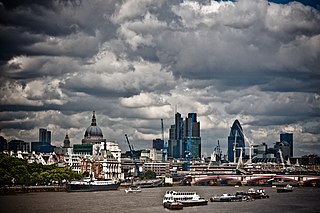
Liquidation is the process in accounting by which a company is brought to an end. The assets and property of the business are redistributed. When a firm has been liquidated, it is sometimes referred to as wound-up or dissolved, although dissolution technically refers to the last stage of liquidation. The process of liquidation also arises when customs, an authority or agency in a country responsible for collecting and safeguarding customs duties, determines the final computation or ascertainment of the duties or drawback accruing on an entry.

In accounting, insolvency is the state of being unable to pay the debts, by a person or company (debtor), at maturity; those in a state of insolvency are said to be insolvent. There are two forms: cash-flow insolvency and balance-sheet insolvency.
A fraudulent conveyance or fraudulent transfer is the transfer of property to another party to prevent, hinder, or delay the collection of a debt owed by or incumbent on the party making the transfer, sometimes by rendering the transferring party insolvent. It is generally treated as a civil cause of action that arises in debtor/creditor relations, typically brought by creditors or by bankruptcy trustees against insolvent debtors, but in some jurisdictions there is potential for criminal prosecution.
Wrongful trading is a type of civil wrong found in UK insolvency law, under Section 214 Insolvency Act 1986. It was introduced to enable contributions to be obtained for the benefit of creditors from those responsible for mismanagement of the insolvent company. Under Australian insolvency law the equivalent concept is called "insolvent trading".
An unfair preference is a legal term arising in bankruptcy law where a person or company transfers assets or pays a debt to a creditor shortly before going into bankruptcy, that payment or transfer can be set aside on the application of the liquidator or trustee in bankruptcy as an unfair preference or simply a preference.
In company law, fraudulent trading is doing business with intent to defraud creditors.

United Kingdom insolvency law regulates companies in the United Kingdom which are unable to repay their debts. While UK bankruptcy law concerns the rules for natural persons, the term insolvency is generally used for companies formed under the Companies Act 2006. Insolvency means being unable to pay debts. Since the Cork Report of 1982, the modern policy of UK insolvency law has been to attempt to rescue a company that is in difficulty, to minimise losses and fairly distribute the burdens between the community, employees, creditors and other stakeholders that result from enterprise failure. If a company cannot be saved it is liquidated, meaning that the assets are sold off to repay creditors according to their priority. The main sources of law include the Insolvency Act 1986, the Insolvency Rules 1986, the Company Directors Disqualification Act 1986, the Employment Rights Act 1996 Part XII, the EU Insolvency Regulation, and case law. Numerous other Acts, statutory instruments and cases relating to labour, banking, property and conflicts of laws also shape the subject.
Bednash v HearseyorRe DGA (UK) Ltd[2001] EWCA 787 is a UK company law and UK insolvency law case, which held that a director's pay and pension was excessive and grossly negligent, and could be recovered after the company went insolvent.

R v Grantham [1984] QB 675 is a UK insolvency law case which decides that an intent to defraud, now under the Insolvency Act 1986 section 213, needs to be established for a conviction for fraudulent trading, and knowing that there was no prospect of being able to pay debt when they fell due, even if there might be a distant prospect in the future, constituted an intent to defraud.

Re Augustus Barnett & Son Ltd [1986] BCLC 170 is a UK insolvency law case on the standard of fault required to show that directors have been guilty of fraudulent trading.
Re Sarflax Ltd [1979] Ch 592; [1979] 1 All E.R. 529 is a UK insolvency law case concerning voidable preferences and fraudulent trading, now in the Insolvency Act 1986. It concerns the definition of "intention to defraud", which is found in a number of legal provisions.

Re Produce Marketing Consortium Ltd [1989] 5 BCC 569 was the first UK company law or UK insolvency law case under the wrongful trading provision of s 214 Insolvency Act 1986.

Re MC Bacon Ltd [1990] BCLC 324 is a leading UK insolvency law case, concerning transactions at an undervalue and voidable preferences.

Re Barleycorn Enterprises Ltd [1970] Ch 465 is a UK insolvency law case, concerning the priority of creditors in a company winding up. It was held that fees for liquidation came in priority to preferential claims and floating charges. This was overturned by the House of Lords in Buchler v Talbot, but reinstated by Parliament through an amendment to the Insolvency Act 1986 s 176ZA.

Morphitis v Bernasconi[2003] EWCA Civ 289 is a UK insolvency law and company law case, concerning fraudulent trading.

Re Brian D Pierson (Contractors) Ltd [1999] BCC 26 is a UK insolvency law and company law case, concerning misfeasance and wrongful trading.

Re Kayford Ltd (in liquidation) [1975] 1 WLR 279 is a UK insolvency law and English trusts law case, concerning the creation of a trust over payments made by consumers, in an insolvent company.

Cayman Islands bankruptcy law is principally codified in five statutes and statutory instruments:

Hong Kong insolvency law regulates the position of companies which are in financial distress and are unable to pay or provide for all of their debts or other obligations, and matters ancillary to and arising from financial distress. The law in this area is now primarily governed by the Companies Ordinance and the Companies Rules. Prior to 2012 Cap 32 was called the Companies Ordinance, but when the Companies Ordinance came into force in 2014, most of the provisions of Cap 32 were repealed except for the provisions relating to insolvency, which were retained and the statute was renamed to reflect its new principal focus.

Re Taylor is a leading New Zealand case on when the High Court will exercise its discretion and refuse to adjudicate a debtor bankrupt.